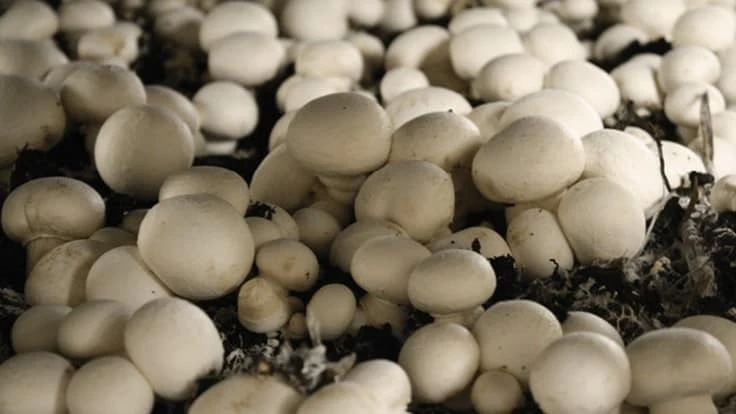

When you think of controlled environment agriculture, mushrooms might not be the first crop that comes to mind. But why not? Using controlled environments to produce mushrooms is a great use of technology to produce another important class of edible crops.
There are a wide variety of mushrooms commercially grown and popular with consumers. These include oyster (Pleurotus ostreatus), shiitake (Lentinula edodes), maitake (Grifola frondosa), and lion’s mane (Hericium erinaceus), as well as several others. However, the most widely grown mushroom in North America is the common mushroom, Agaricus bisporus (Fig. 1). This article is going to focus on producing button mushrooms, since they are the most important from a commercial standpoint.
There are three primary varieties of Agaricus bisporus grown, including the white cap, off-white cap and brown varieties. The white cap variety is the highest-yielding of the varieties, and it is also the most commonly grown for processing. However, growing for fresh market sales allows producers to charge a more premium price compared to sales for processing. For fresh-market sales, the off-white and brown varieties are the most popular.
Mushroom production utilizes controlled environments just like nearly all other food crops grown in soilless culture; in fact, mushroom production was one of the first industries to utilize vertical farming techniques! To maximize mushroom growth and development, rooms with controllable air temperature and humidity are best (Fig. 2). While lighting is necessary in these growth rooms, the lighting is to aid people when they are working in these rooms and is not for mushroom growth, in contrast to the intensive and extensive lighting required for photosynthetic crops.

The growing substrate or compost used for producing mushrooms is comprised of carbohydrate and protein. Traditionally, mushroom compost has been comprised of straw-bedded horse manure and straw or hay. However, in order to produce a more consistent compost year-round, “synthetic” compost is made by combining straw (the carbohydrate) with poultry manure (the protein). These components are then composted, and after microorganisms reduce soluble sugars and ammonia they will die and serve as “food” for the mushrooms.
In order to start a new crop of mushrooms, mycelia or “spawn” are used to inoculate the compost. Spawn is prepared by using a steam-sterilized cereal grain such as millet, rye, or wheat mixed with calcium carbonate with Agaricus mycelia. In planning how much spawn is needed for production, one pound of spawn will yield approximately 120 pounds of mushrooms. Spawn can either be broadcast on top of compost, mixed into the top 0.5 to 3 inches of compost, or fully incorporated throughout the compost.Using controlled environments to produce mushrooms is a great use of technology to produce another important class of edible crops.
Mushrooms must be forced to form the fruiting structures that are harvested and sold. To force the mushroom to move from a vegetative state to reproductive state, a “casing” layer is placed on top of the substrate ). This is most commonly done using peat moss, though other materials such as coconut coir or bovine or equine manure are also used. By carefully managing the moisture of the casing, the fruiting structures of the mushroom start to form ).
As the mushrooms develop, harvesting will depend on the final product. For baby mushrooms, obviously they will be harvested at an earlier stage when the fruiting body is smaller and gills less exposed. On the other end of the spectrum, the mushrooms can be allowed to develop and harvested when the cap is large and the gills are very exposed; this would be the strategy for producing portabella mushrooms, which are simply mature brown-strain Agaricus mushrooms. Mushrooms are harvested by hands with very sharp, curved blades which allow for harvesting without damaging stems.
While mushrooms may not be the first crop you think of when considering controlled-environment agriculture, they should definitely be on the list! Mushrooms can add diversity to any producer’s portfolio or serve as a primary crop.

Explore the June 2021 Issue
Check out more from this issue and find your next story to read.
Latest from Produce Grower
- TIPA Compostable Packaging acquires paper-based packaging company SEALPAP
- Divert, Inc. and General Produce partner to transform non-donatable food into Renewable Energy, Soil Amendment
- [WATCH] Sustainability through the value chain
- Growing leadership
- In control
- The Growth Industry Episode 8: From NFL guard to expert gardener with Chuck Hutchison
- 2025 in review
- WUR extends Gerben Messelink’s professorship in biological pest control in partnership with Biobest and Interpolis





